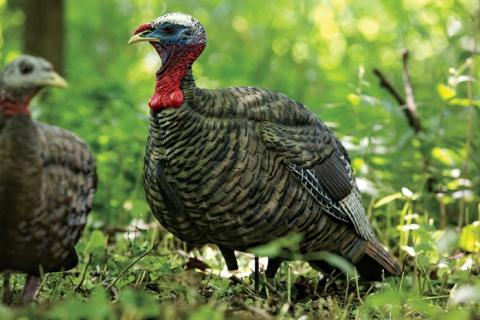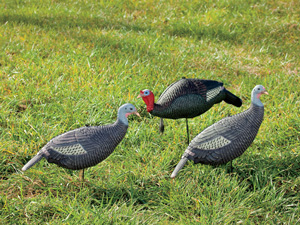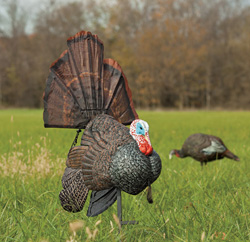
When I was a kid I never heard of a turkey decoy. Now, there are a ton to choose from. Which one is the best? I don't want to beat around the bush, but to answer that question I'll have to first ask you a few questions.
 |
| If you're heading up the mountains to do your turkey hunting, consider foam turkey decoys to decrease the weight on your pack. |
Do you hunt in an area that you can drive to? Are you going to be hunting out of a blind or walking around all day? Do you hunt in the mountains where light-weight gear is of an essence? All of these factors will determine which decoy you will need to choose.
So I'm going to recommend different decoys for different scenarios and you pick the scenario that best fits your situation.
Mountain Hunting for Turkey
Where I hunt in Idaho I could never carry a decoy that weighed very much, hauling it up and down the mountains all day. If I'm hitting it hard in the mountains I want a decoy that will fold up and be compact so it doesn't take a moving van to transport. I also want one that I can slap up in a hot second. Many times in a hunt you'll have panic in the disco and have stumbled into a deal that requires a quick set-up. In these times either you have a decoy that you can slap up right fast or you'll have to do a set-up without a decoy.
So for mountain hunting I need a collapsible lightweight decoy that is easily assembled. This limits me to using either a Montana Decoy or a foam decoy. A Montana Decoy snaps out fast and is easy to set up. They are one dimensional so you may want to use two of them.
Some of the foam decoys get a permanent crease where you fold them and don't look realistic so buy one that pops out easily. Try them and you'll see what I mean. I have some that don't seem to mind if you wad them all up and some are more touchy.
Soil Matters When Setting Turkey Decoys
What kind of soil do you hunt in? If you hunt in rocky soil then you need to get a decoy that has a sturdy stake or improvise and make your own. If you lose a stake, don't panic. I'm sure that you can buy replacements, but I've made my own by grinding down the end of an all-thread so it has a point which can stick out of the ring on the turkeys back. Weld a washer 1/2-inch down the bolt so it can't go through the decoy. Grind down the other end so it can be stuck in the ground.
You'll also want a backpack that has a lot of space and will hold a lot of volume. That way you can throw 2-3 decoys in the pack without smashing them up. You'll also want room to hold a whole passel of calls. Some people want an orange drop cloth on the back of their backpack so it can be dropped for visibility when you're packing out a bird.
Realistic Turkey Decoys
If you're going to be able to pretty much drive up to where you're hunting then I'd use the most realistic one that I could afford. The MOJO Shake-n-Jake Motion Turkey Decoy looks pretty cool. It is a remote controlled full motion decoy.
 |
| Realistic turkey decoys, which use a remote to make the decoy move, are perfect for calling in Toms. |
If you can only have one decoy though you'll want a gobbler (preferably a Jake). When a Tom comes in he's going to go right to the Jake. It's better to have a Jake and a hen or two. My buddy Ed Sweet, who is one of the best turkey hunters in America, has a video of a gobbler that he called in for his dad, the world famous duck decoy carver Jack Sweet. As soon as his dad rolled him a smaller gobbler jumped on top of him and started spurring the tar out of him. This shows that there is a definite dominance structure in the turkey world. The younger one had gotten tired of being beat up on and kicked the big daddy when he was down!
Where Do You Set Your Decoys?
So where do you set up your decoys? That's the million dollar question. It works best if you can get in line with where they're wanting to go anyways and intercept them. Another favorite tactic, let's say that you roosted some the night before. Go in way before daylight and set up in an open spot maybe 100-150 yards from the roost. Set up so right at daylight when they start talking that you can lure them down your way. You don't want the decoy out 50 yards. Why? What if he comes from the opposite direction and stops 20 yards from your decoy? He's 70 yards from you.
So set up so as to have you in a good ambush spot. Turkeys eyesight is legendary so camo and hide really good. That's another reason we use decoys. Hopefully while they're coming in they'll be looking at the decoy instead of you.
If you know a field where they'll be feeding, set up on the edge and put your decoys out in it 20 yards and you can get concealed on the edge. Set with your left side somewhat facing them so you can turn easier for a shot without too much movement. Many people like shooting sticks.
Let's end on a word of safety. For whatever reason it seems more people get shot turkey hunting than most other events combined. For this reason many people recommend setting with your back against a tree. Don't set in the line of fire where someone may come sneaking in from.
A buddy of mine was working a group of turkeys and some kids came in as well. They waved them off but one of them saw his buddy move and shot him. He had over 100 BB's in his back and neck. Don't put someone or yourself through this trauma. Be careful.
- 9812 views

